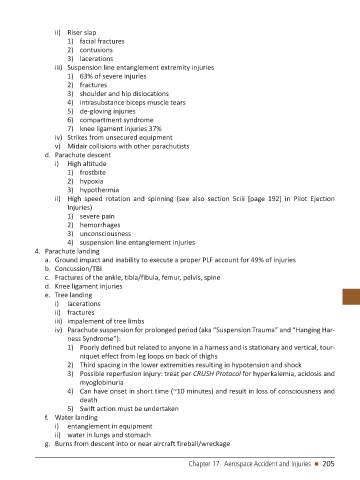Page 207 - PJ MED OPS Handbook 8th Ed
P. 207
ii) Riser slap
1) facial fractures
2) contusions
3) lacerations
iii) Suspension line entanglement extremity injuries
1) 63% of severe injuries
2) fractures
3) shoulder and hip dislocations
4) intrasubstance biceps muscle tears
5) de-gloving injuries
6) compartment syndrome
7) knee ligament injuries 37%
iv) Strikes from unsecured equipment
v) Midair collisions with other parachutists
d. Parachute descent
i) High altitude
1) frostbite
2) hypoxia
3) hypothermia
ii) High speed rotation and spinning (see also section 5ciii [page 192] in Pilot Ejection
Injuries)
1) severe pain
2) hemorrhages
3) unconsciousness
4) suspension line entanglement injuries
4. Parachute landing
a. Ground impact and inability to execute a proper PLF account for 49% of injuries
b. Concussion/TBI
c. Fractures of the ankle, tibia/fibula, femur, pelvis, spine
d. Knee ligament injuries
e. Tree landing
i) lacerations
ii) fractures
iii) impalement of tree limbs
iv) Parachute suspension for prolonged period (aka “Suspension Trauma” and “Hanging Har-
ness Syndrome”):
1) Poorly defined but related to anyone in a harness and is stationary and vertical, tour-
niquet effect from leg loops on back of thighs
2) Third spacing in the lower extremities resulting in hypotension and shock
3) Possible reperfusion injury: treat per CRUSH Protocol for hyperkalemia, acidosis and
myoglobinuria
4) Can have onset in short time (~10 minutes) and result in loss of consciousness and
death
5) Swift action must be undertaken
f. Water landing
i) entanglement in equipment
ii) water in lungs and stomach
g. Burns from descent into or near aircraft fireball/wreckage
Chapter 17. Aerospace Accident and Injuries n 205

